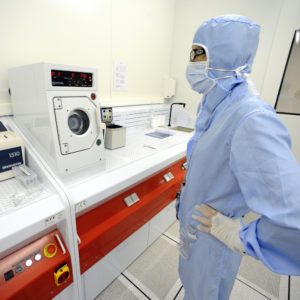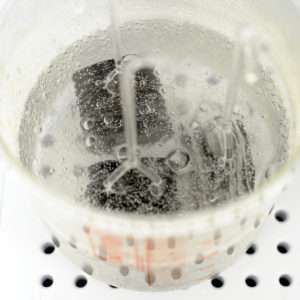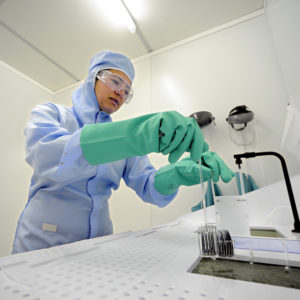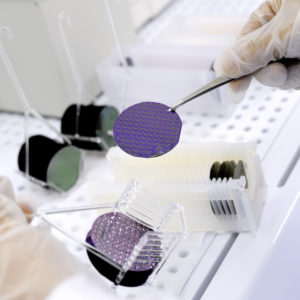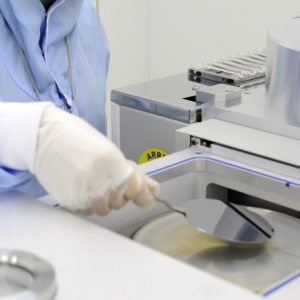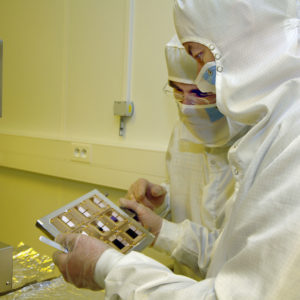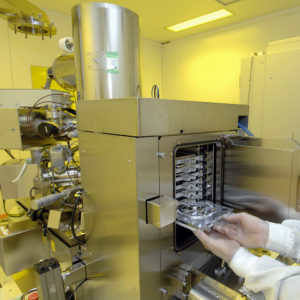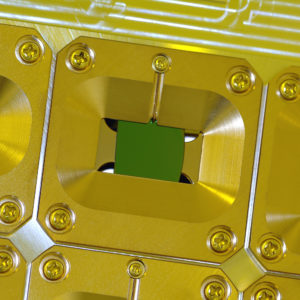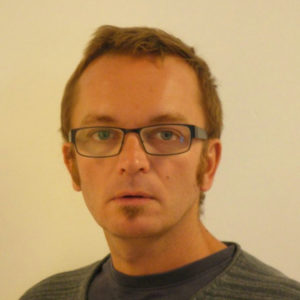The PTA, Upstream Technological Platform, is a 1000 class clean room resulting from the pooling of technical and human resources of IRIG (Institut de recherche interdisciplinaire du CEA Grenoble) and LTM (Laboratoire des Technologies de la Microélectronique du CNRS, UJF et INP). The clean room extends over 700 m2, 350 m² on CEA site and 350 m² in the Grenoble INP site, within the CIME clean room ( InterUniversity MicroElectronics and nanotechnologies Centre).
The PTA offers the technical capabilities needed to cover a wide range of projects in nanosciences andmicro- nanotechnologies: complementary methods and equipment facilities for lithography, deposition or etching enable reliable integration of nano-objects and nano-materials or patterning of thin layers in the nanometric range. The PTA can accommodate all types of substrates from small 5 x 5 mm² sample up to the 100 mm wafers. A huge diversity of materials can be processed within a reasonable approach of contamination management
The research fields are numerous: nanoelectronics, MEMS & NEMS, magnetism and spintronics, integration of nano-materials and nano-objects, photonics, … The purpose of the facility is both to provide the needed means and skills to researchers, and to welcome industrial companies looking for a place to develop theirprojects.
Flexibility, ease of access and use, are the cornerstone of the management of the PTA. This pooling of facilities between the major players of upstream research in Grenoble means that a specific management system had been set up combining INAC and LTM complementary views and needs: here, users will find both a state of the art facility and an optimal flexibility.
The Team
Recent news
- Spintronic memristor based on an isotropically coercive magnetic layer (December 03rd, 2019)

We propose an original concept of spintronic memristor based on the angular variation of the tunnel magnetoresistance (TMR) of a nanopillar comprising several magnetic layers. We have experimentally developed the appropriate magnetic free layer and ... - Magnetic control of optical responses of biocompatible magneto-elastic membranes (August 29th, 2019)

Numerous studies investigated the use of synthetic membranes for photonic or biomedical applications. We report here on a recent type of biocompatible magnetically actuated membranes, partly originating from studies on magnetic particles for biology, consisting ... - Impact of heating on the stability phase diagrams of perpendicular MTJs (February 19th, 2019)

Measured switching diagrams of perpendicular magnetic tunnel junctions exhibit unexpected behavior at high voltages associated with significant heating of the storage layer. The boundaries deviate from the critical lines corresponding to the coercive field, which ... - Highly Efficient Spin-to-Charge Current Conversion in Strained HgTe Surface States Protected by a HgCdTe Layer (October 03rd, 2018)

We report the observation of spin-to-charge current conversion in strained mercury telluride at room temperature, using spin pumping experiments. We show that a HgCdTe barrier can be used to protect the HgTe from direct contact ... - Sub-10nm thermally stable Perpendicular Shape Anisotropy magnetic memory (August 24th, 2018)

A new concept of thermally stable and electrically switchable Spin Transfer Torque Magnetic Random Access Memory (STT-MRAM) scalable to diameter down to 4nm was proposed and demonstrated. By dramatically increasing the thickness of the storage ...

